20+ SAMPLE Artist Proposal
-

Artist Proposal Template
download now -
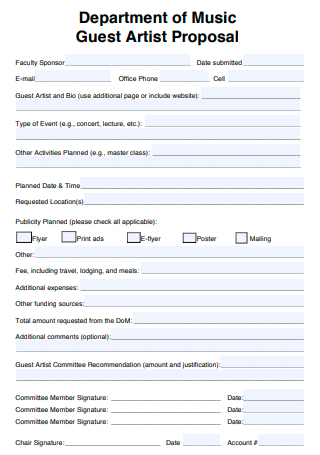
Department of Music Guest Artist Proposal
download now -

Call to Artists Proposal
download now -
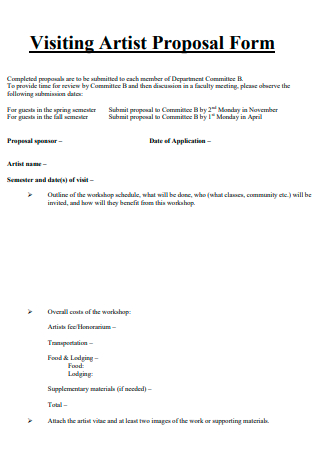
Visiting Artist Proposal Form
download now -
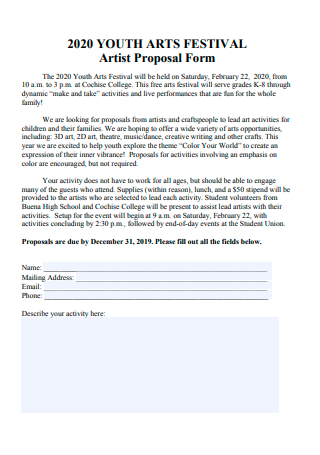
Youth Arts Festival Artist Proposal Form
download now -
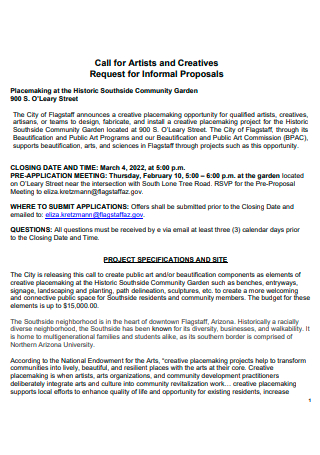
Call For Artist and Creatives Proposal
download now -

Artist Proposal Example
download now -
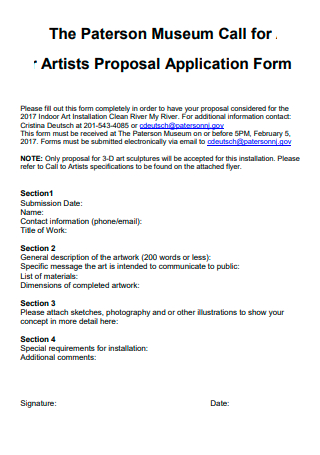
Artists Proposal Application Form
download now -
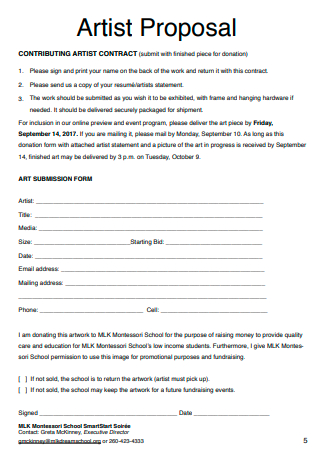
Artist Proposal in PDF
download now -
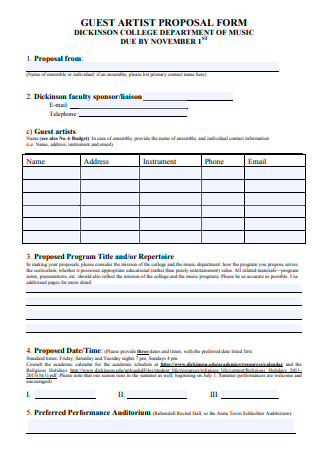
Guest Artist Proposal Form
download now -

Artist Exhibit and Interactive Program Proposal Questionnaire
download now -
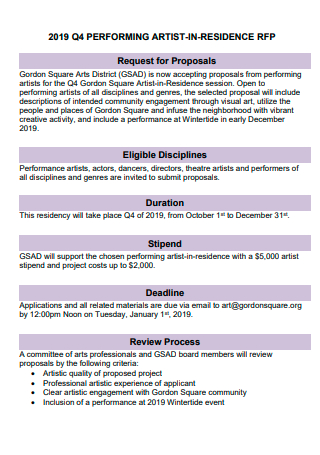
Artist in Residence Proposal
download now -
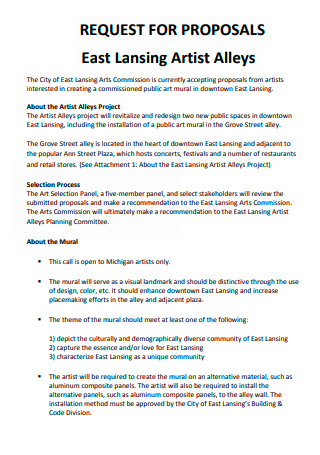
Printable Artist Proposal
download now -
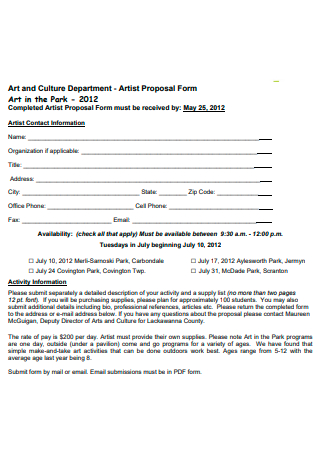
Artist Proposal Form
download now -
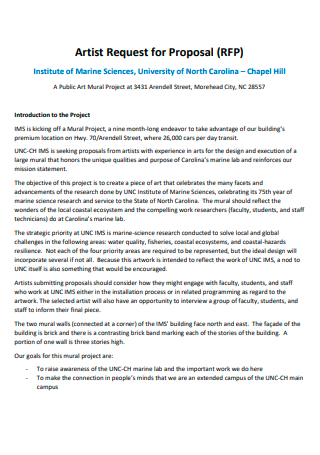
Artist Request For Proposal
download now -
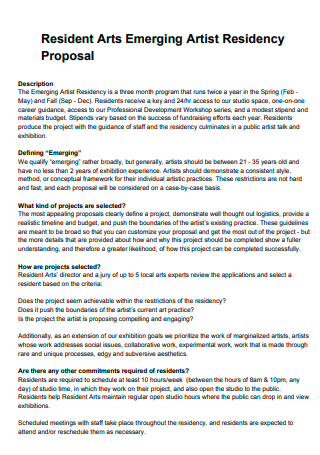
Artist Residency Proposal
download now -
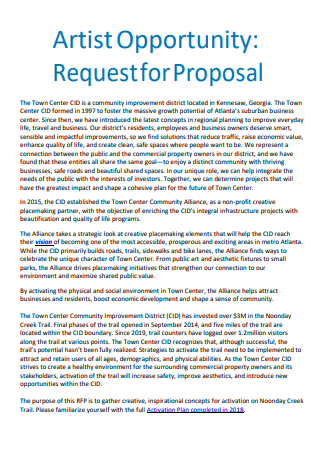
Artist Opportunity Proposal
download now -
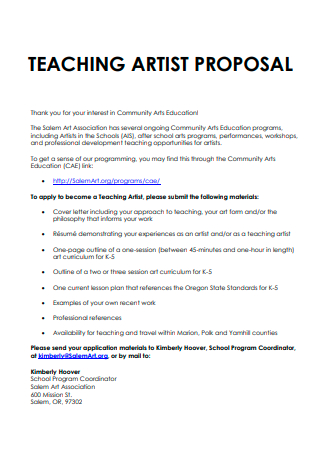
Teaching Artist Proposal
download now -
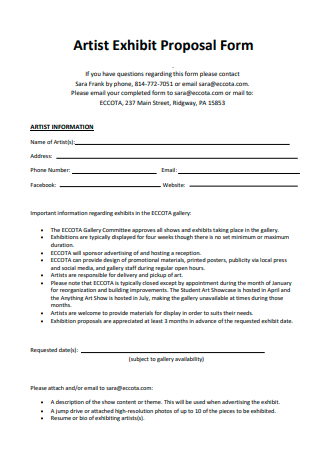
Artist Exhibit Proposal Form
download now -
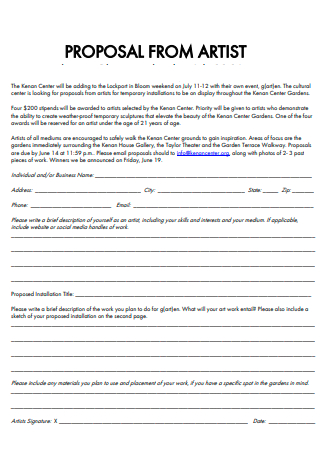
Formal Artist Proposal
download now -
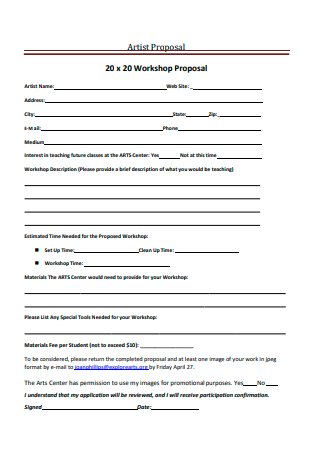
Artist Workshop Proposal
download now
What Is an Artist Proposal?
An artist proposal allows an artist to exhibit their work in a museum, organization, or event for a short time. You may also be asked to write creative grant submissions in order to acquire financing for huge projects. A proposal is comparable to a resume in that it must be concise, coherent, and compelling, and its goal is to obtain the reader’s acceptance or approval. You will need to be aware of what goes into each section to ensure no important information is left behind. A Proposal for artist performance must accentuate what you are capable of doing. Make use of the artist proposal template readily available.
Tips for Beginner Artists
Remember that every professional started out as a novice. It makes no difference how old you are, whether you have a formal art background, or whether this is your first time holding a brush in your hands. There is a common misconception that not everyone can become an artist. But you can pursue it if you really want to. This list will assist you in avoiding blunders at the start of your artistic journey. These painting techniques and tactics can come in handy. Even if you have no idea where to begin, these beginner painting guidelines will assist you.
Necessary Equipment for Artists
If you are an artist who is only starting out, you would be curious about what tools and equipment you will be needing to start your art journey. This curated list will give you the basics on what items you should secure. Whether you work in traditional media, a less traditional medium like light, or in installation or performance art, or even a non-professional art piece merely for a sketch. And if you know fellow artists, these would also make excellent Christmas Gifts. Even if the receiver already has a well-stocked studio, a high-quality tool is always welcome. Consider putting together a few items to create a handy kit.
How to Write an Artist Proposal
Writing an artist proposal would not be a smooth process if you are unfamiliar with the contents and specifications of each section. This is why this article has been made to guide you through each step and ensure you did not overlook any of the parts. If you want to be thoroughly sure, you can view the artist proposal sample and view the already completed documents as a comparison to what you will be making.
1. Obtain Background Information
It may seem contradictory, but the first step in drafting a good art proposal isn’t putting pen to paper or considering what to write. It is going on an in-depth study on your readers, who they are, and what they are looking for. Begin by reviewing the rules for the grant or exhibition for which you are submitting the Proposal. This stage will provide you with a wealth of information about the kind of work that the curators require for the show or are looking to support, allowing you to personalize your proposal to match their needs.
2. Gather Perfect Images
You will be expected to include Photographs in your artist proposal 100 percent of the time. The images you offer in your proposal will represent your artwork to the reader of your entry, therefore they must be of the highest quality. The best approach to duplicate your photographs is most likely not to do so yourself. Using your smartphone to take photos of your artwork to include in an artist proposal is a terrible notion that you should never consider. You may always employ a professional photographer to make a high-quality reproduction of your artwork for an artist proposal.
3. Prepare Objectives
Write down the goals of the project you are proposing. Consider what you want to achieve and why you want the assistance of this company. If you want to enter an art competition, consider what makes your work unique and why this organization should include it in its display. It is important for you to establish the Objectives of your individuality so that the readers or event organizers will be able to distinguish if you are fit for the venue or event theme or not.
4. Write a Budget
Not all proposals require a Budget Estimate, but if they do, it’s a good idea to start putting one together at the same time as your artist proposal. Begin by making a list of your costs. Write down everything you need to be as precise as possible. Material costs, flights, labor, studio space, software, and other expenditures will be included. So, read attentively and leave out these categories. A budget list may also help you explore what you need to make your idea a reality, as well as provide critical comments for your draft. Don’t forget about your own labor expenses.
5. Prepare Additional Documents
Funders will want a Curriculum Vitae (CV) or a biography. This is used to evaluate your education, honors, residencies, exhibits, and other achievements. A bio is usually a short 100-200 word statement written in the third person. In a paragraph summarizing your background, it provides the most noteworthy awards. A CV, on the other hand, is a long summary of all of your experiences. Education, exhibits, publicity, publishing, residencies, performances, and artist lectures are some examples. A CV is an excellent choice for an artist with a long professional history since it allows them to highlight all of their achievements throughout their career.
6. Submit and Follow Up
Following up after submitting your art grant submission is advised by some artists. This may be an excellent concept at a smaller institution, but in a larger university, you may have difficulty reaching anybody who can help you. Follow up nevertheless, thanking the donors for their consideration and asking if they have time to tell you what needs to be improved in your arts grant submission. You might not have obtained the grant because of the jurors’ preferences. Any input is beneficial, and you may transform the loss of a grant into a learning experience.
FAQs
What makes a successful art exhibition?
The finest art shows include a recurring subject or theme line that connects all of the pieces to produce a feeling of coherence. Your display should express a message that is important to you. Images, phenomena, sensations, and specific visual approaches are all examples. Some galleries would have you believe otherwise, but the gallery connection is more akin to a collaboration. Galleries give space for their artists to show their work, while artists provide art to the galleries. What sets a solo exhibition proposal apart from the usual artist proposal is the independence of having a specific artist be featured.
What is an art grant proposal?
A grant is a method through which the government finances your ideas and initiatives in order to deliver public services and promote the economy. Grants fund essential recovery measures, cutting-edge research, and a variety of other projects. Writing grant applications is the same as writing grants since both entail acquiring funding for present or future activities. Writing Grant Proposals is an art form since each submission must be accessible, well-written, accurate, and precise.
How long should art proposals be?
Most event organizers, critics, or even investors will frequently want 10 to 20 photos. You must email, upload to a site, even some would prefer sending it in the mail in a CD or DVD, or submit a website URL. Always deliver and organize the work in the manner asked. For example, if a video contribution of four to seven minutes is requested, never send anything greater than seven minutes.
As a beginner in the art industry, there are various things you will need to prepare. Other than sorting out your own preferences and skills, you will need to prepare an art exhibition proposal to showcase the world of your talents and works. With that being said, to avoid feeling rushed to complete the document, make use of the templates and examples provided in this very article.
